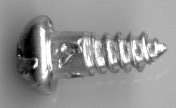One Good Turn
Today, the screwdriver. The University of Houston's College of Engineering presents this series about the machines that make our civilization run, and the people whose ingenuity created them.
Witold Rybczynski, who writes on technologies of the home, offers grist for the listeners who've asked me to talk about screws. His book, One Good Turn, A Natural History of the Screwdriver and the Screw, came about after his editor pressed him to do an article in 1999 on "the most important tool of the past millennium." Ribczynski finally chose, not the screw, but the screwdriver.
Screw threads have been used in machines ever since Archimedes. Ancient screws all took the form of threads wound about a straight cylinder. Tapered screw threads, with their powerful grip, were a lot harder to make, and they appeared much later. Rybczynski finds tapered screws throughout the early Renaissance. They show up in late suits of armor and early firearms. He finds them in Renaissance clockwork and flourmills.


Straight scew (left), Tapered screw (right)
But the story gets interesting because Rybczynski set out to talk about screwdrivers. What he ran into was something we've often seen in this series. That's the remarkable invisibility of so much really important technology. The little things -- the ones we cannot do without -- are precisely what we fail to notice.
 Rybczynski begins his quest with the Oxford English Dictionary -- the OED. Instead of defining words, the OED traces how they were used at different times. The oldest OED reference is from 1812. It quotes a handbook that defines a Screw Driver as "a tool used to turn screws into their places." As Rybczynski looks further, he finds the word screwdriver only here and there, and only as far back as the late 1700s.
Rybczynski begins his quest with the Oxford English Dictionary -- the OED. Instead of defining words, the OED traces how they were used at different times. The oldest OED reference is from 1812. It quotes a handbook that defines a Screw Driver as "a tool used to turn screws into their places." As Rybczynski looks further, he finds the word screwdriver only here and there, and only as far back as the late 1700s.
Then he spots one isolated reference to a gadget called a turnscrew. But that's a literal translation of the French word for a screwdriver -- tournevis. If he's to find any historical reference to screwdrivers, maybe he needs to go to France. Sure enough, Diderot's vast eighteenth-century encyclopaedia of the arts and trades yields one tiny illustration of a screwdriver.
And so the game goes. Rybczinski fights his way back through old documents and artifacts. Early gun-makers began using tapered screws to hold parts together because they were more secure than other fasteners. Some were turned with wrenches, but slots appeared in the top of others. So we know screwdrivers were in use.
Of course tapered screws were hard to make by hand. Not until the nineteenth century would we have automated screw-making machines. Only then did screws become mainstream fasteners. But screwdrivers had existed for centuries before that, and we find virtually no written record of them -- no words, no pictures.
I suspect that's exactly why Rybczynski chooses the screwdriver as the most important tool of the millennium. Each of us owns several of them. Yet, down through centuries, they've been utterly taken for granted and deemed to be beneath any mention in our books. Find a better marker of greatness than that if you can -- omnipresence in utter anonymity.
I'm John Lienhard, at the University of Houston, where we're interested in the way inventive minds work.
(Theme music)
Rybczynski, W., One Good Turn: A Natural History of the Screwdriver and the Screw. New York: Scribner, 2000. (I am grateful to the good people at Brazos Bookstore in Houston, Texas, for singling out this book and providing me with a copy.)